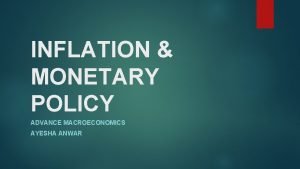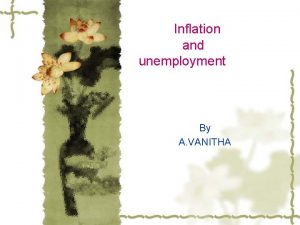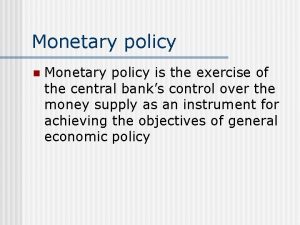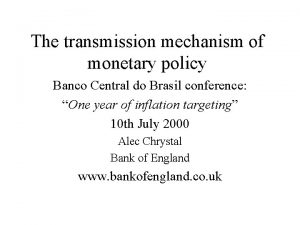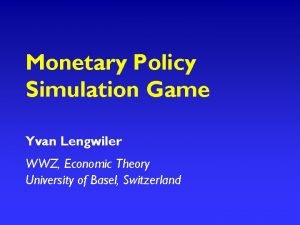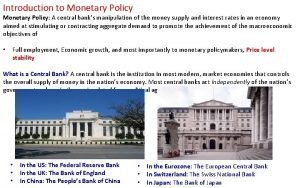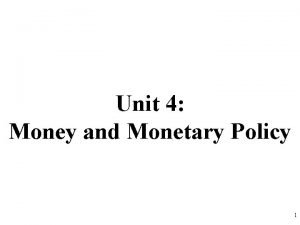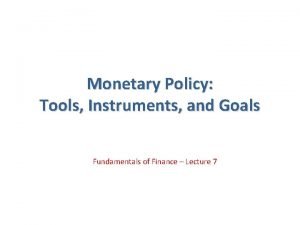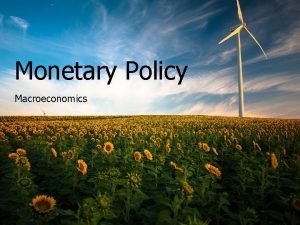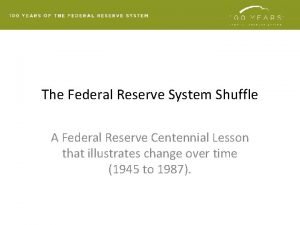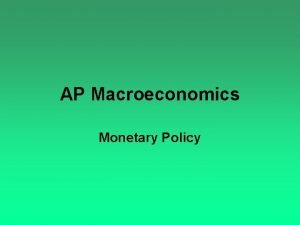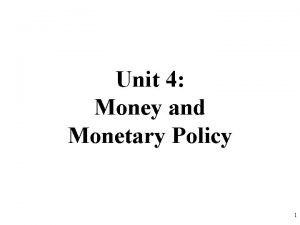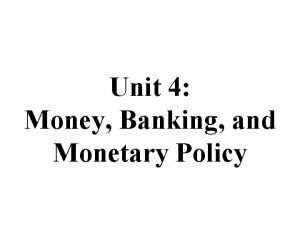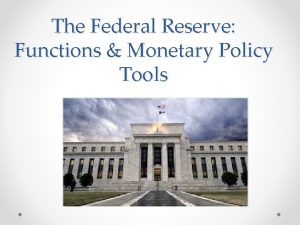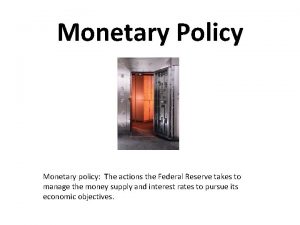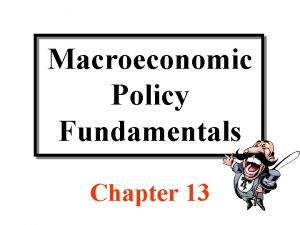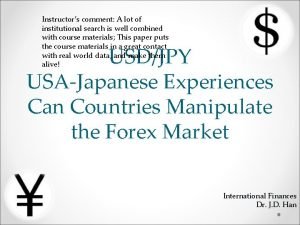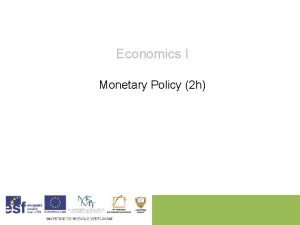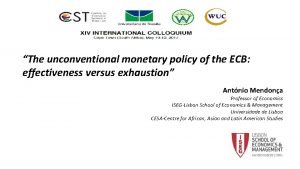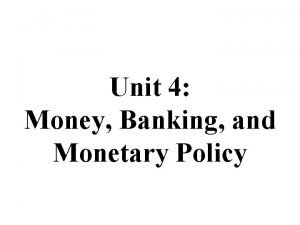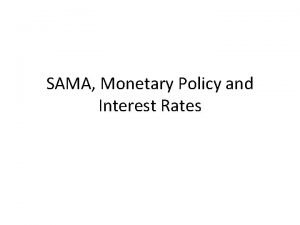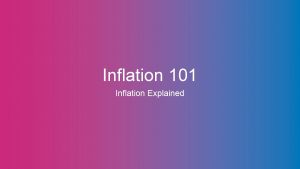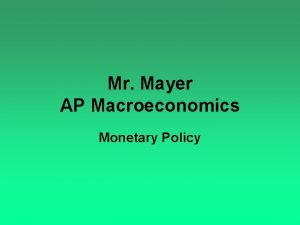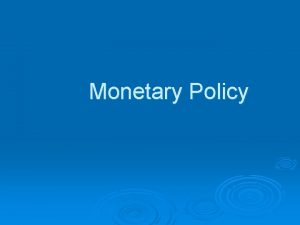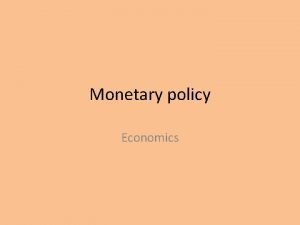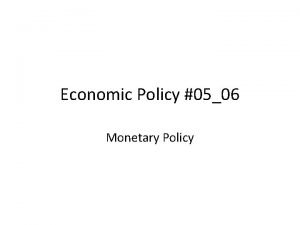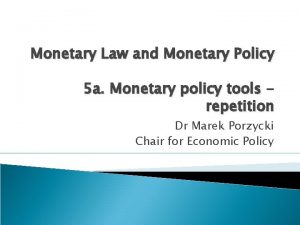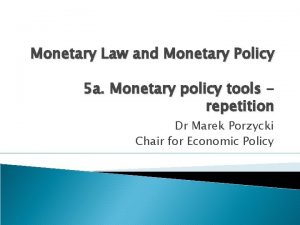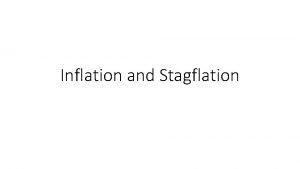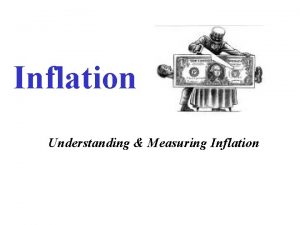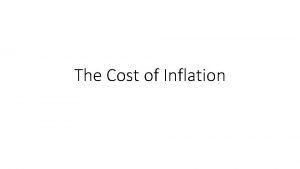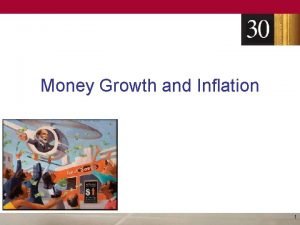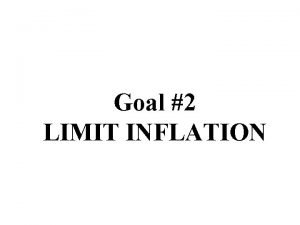INFLATION MONETARY POLICY ADVANCE MACROECONOMICS AYESHA ANWAR Outlines




























- Slides: 28

INFLATION & MONETARY POLICY ADVANCE MACROECONOMICS AYESHA ANWAR

Outlines Inflation Types of Inflation Causes of Inflation Relationship of Inflation, Money growth and Interest Rate Term Structure of Interest Rate Back ward Looking Model Forward Looking Model Dynamic Inconsistency

Monetary Policy and Inflation As Milton Friedman said “inflation is always and everywhere a monetary phenomenon. ” Much of the study of inflation has focused on episodes of hyperinflation. During hyperinflations, when prices are rising by hundreds or thousands of percent per year. Another aspect of inflation that has received a great deal of attention from monetary and macroeconomists is the question of how to reduce it. Does monetary policy have real effects? There seem to be systematic positive correlations between money growth and output growth in most industrial countries. On the other hand, the real-business-cycle theorists explain that correlation with the reverse causality. Rapid output growth leads to higher growth in the demand for money.

Issues in Monetary Policy There are many distinct issues involved in the study of monetary policy. Some are central issues such as studying how monetary policy affects the economy Others are relate to the policy process itself, the structure and stability of financial markets, and the regulation and supervision of the banking industry. The macroeconomic questions relating to monetary policy tend to fall into two major categories: long-run inflation control and short-run stabilization policy.

Inflation Types Causes Creep Demand Pull Walk Cost Push Run Excessive Hyper inflation money Supply Wage-Price Spiral Stagflation

1. 1 inflation, Money Growth and Interest Rate


Long Run Scenario: In the long run Money Supply comes up as the most component affection price level. Not only money effects price level But also money Growth causes most variation in Aggregate Demand (Demand push inflation). What happens to the other variables? (i, Y, MD) v The interest rate here in nominal interest rate and we are usually interested in real v In long run output necessarily does not reduce v Usually income elasticity of demand is 1 and interest Elasticity is ( -0. 2). (see Goldfeld and Sichel 1990)

1. 1. 2 Money Growth and Interest rates


The effects of an increase in money Growth

1. 2 Monetary Policy and Term Structure of Interest Rates What is term Structure of Interest Rates? The relationship among interest rates over different horizons in called TERM STRUCTURE OF INTEREST RATES and the standard theory that explains this relationship is called EXPECTATIONS THEORY OF THE TERM STRUCTURE. IN SHORT we will study the relationship of long term and short term interest rates.

The Expectations Theory of the Term Structure


1. 3 Optimal Monetary Policy in a Simple Backward-Looking Model



Monetary policy in a forward-looking model The simplest form of the monetary-policy rule suggests that by “divine coincidence” monetary policy is able simultaneously to minimize both terms of the central bank’s loss function: there is no tradeoff between minimizing inflation and keeping output near the natural level because the policy that does one also does the other.

Dynamic Inconsistency MS ↑, interest rate ↓, Investment ↑, Consumption ↑, AD↑, Y↑ This process is called Monetary Transmission Mechanism. The process by which Monetary variables effect real variables o Channels 1) interest rate 2) credit 3) wealth 4) exchange rate. o It may be in the interest of the central bank in the short run to “fool” the public by increasing the money supply more rapidly than people expect. However, agents with rational expectations cannot be fooled forever. o since inflation increases as monetary growth accelerates, the long-run cost of such short-run stimulative policy actions is higher inflation

If the price of the shirt is likely to increase. What will happen? Mankiw View Maradona theory AS Price AS’ AS P’ P AD’ AD output

Kydland Prescott also assume that inflation above some level is costly, and that the marginal cost of inflation increases as inflation rises. A simple way to capture these assumptions is to make social welfare quadratic in both output and inflation. Thus the policymaker minimizes the loss Function. The quadratic welfare function is as follows: The policy objective function, which may or may not correspond to the true social welfare function of the agents in the economy, it is like a utility function for policymakers. This function expresses a cardinal preference measure for the policymaker as a function of major economic variables. In the present example, it is a function of output and inflation, though unemployment is often used in place of output.

In the present case, it is more convenient to express the policymaker’s preferences in terms of minimizing a loss function rather than maximizing an objective function. The only difference between a positive objective function and a loss function is whether it is defined in a way that makes increases in the function good or bad. In the objective function case, increases in the function are good and the policymaker attempts to maximize the function; with the loss function, increases in the function are bad and the policymaker’s goal is to minimize the function.

There are two crucial assumptions that are necessary to support that main result of this model. The first is that inflation is undesirable above some value π*. The second is that the optimal level of output y* is greater than the natural level yn to which the economy gravitates in long-run equilibrium with correct expectations. So the first order condition will be Solving it for π :

If expected inflation were to remain constant, the policymaker would achieve lower loss by following this short-run rule than with the π = π* rule In the long run, however, agents will catch on to any higher inflation and adjust their expectations. That means that any level of inflation that is higher (or lower) than the expected rate will not be sustainable. For any given level of inflationary expectations, one can calculate the policymaker’s optimal short-run response. This is the “reaction function” that is represented by the flatter upward-sloping curve in Figure


Seigniorage and Inflation profit made by a government by issuing currency, especially the difference between the face value of coins and their production costs. The issuance of new money is a very profitable enterprise. Newly created money can be used to purchase goods and services, thus it conveys “income” to its issuer. However, if the economy is at full employment and money is neutral, then the issuance of new money does not directly lead to the production of additional goods and services. Since the central bank usually issues new money by purchasing government bonds or (which is the same thing) making loans directly to the government, this “income” is typically transferred from the central bank to the government and becomes the inflation tax.

Who pays the inflation tax? Seigniorage via inflation is a source of government revenue just like income taxes, sales taxes, property taxes, import tariffs, etc. Since the inflation tax is a tax on money balances (called the “tax base”), this is nothing more than the familiar principle of taxation that an increase in a tax rate will cause people to reduce the tax base. If an increase in the tax rate (the inflation rate in this case) causes the tax base (real money balances) to decline by enough, it is possible that the amount of revenue would actually decline. This is represented by the inverse-U-shaped inflation-tax Laffer curve:

Thank you
 Dr ayesha anwar
Dr ayesha anwar Cjis security training
Cjis security training Futa inflation meaning
Futa inflation meaning Büdcə vergi siyasəti
Büdcə vergi siyasəti Instruments of monetary policy
Instruments of monetary policy Transmission of monetary policy
Transmission of monetary policy Monetary policy simulation game
Monetary policy simulation game Contractionary money policy tagalog
Contractionary money policy tagalog Types of monetary policy
Types of monetary policy Unit 4 money and monetary policy
Unit 4 money and monetary policy Define moral suasion
Define moral suasion Three tools of monetary policy
Three tools of monetary policy What is expansionary monetary policy
What is expansionary monetary policy Expansionary monetary policy flow chart
Expansionary monetary policy flow chart Lesson quiz 16-1 monetary policy
Lesson quiz 16-1 monetary policy Monetary policy types
Monetary policy types Contractionary money policy
Contractionary money policy Unit 4 money and monetary policy
Unit 4 money and monetary policy Unit 4 money banking and monetary policy
Unit 4 money banking and monetary policy Ano ang tight money policy
Ano ang tight money policy Monetary policy summary
Monetary policy summary What is monetary policy
What is monetary policy What are the objectives of monetary policy
What are the objectives of monetary policy Conclusion of monetary policy
Conclusion of monetary policy Instruments of monetary policy
Instruments of monetary policy What are the objectives of monetary policy
What are the objectives of monetary policy Ecb unconventional monetary policy
Ecb unconventional monetary policy Unit 4 money banking and monetary policy
Unit 4 money banking and monetary policy Sama exchange rate
Sama exchange rate
